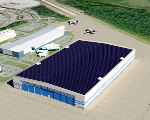
Boeing and South Carolina Electric & Gas have announced an energy partnership that will enable Boeing South Carolina to operate as a 100-percent renewable energy site.
Someday the entire surface area of a building’s windows could be used to generate electricity — without interfering with the ability to see through them.
The most recent earthquake in Japan affected water levels in groundwater wells all over the country.
The P3 award competition and National Sustainable Design Expo were a part of the 2011 EPA Earth Day celebration event April 16-17.
EPA has released the 16th annual U.S. greenhouse gas inventory.
The New York State Attorney General’s Office urged the U.S. Supreme Court to uphold the right of states to sue five polluting power companies to force them to reduce carbon dioxide emissions, the primary cause of climate change.
PlaNYC New York City Brownfield Cleanup Program is the first municipally-run brownfield cleanup program in the nation.
A team of researchers from Spain and Canada have detected flame retardant pollutants in peregrine falcon eggs in both countries.
RecycleMania wrapped up its 11th annual recycling competition in early April. It is an eight-week challenge that ignites classic college rivalries, rallying students, faculty and staff to increase on-campus recycling rates beyond their collegiate competitors.
Iowa State has developed a biorefinery simulator designed to help students in its biorenewable resources and technology program learn about biofuel production.
As more businesses are seeing the advantages of "going green" the Virginia Recycling Association would like to be a resource for businesses that want to find out more about how and what they can recycle.
Strong relationships with faith and neighborhood organizations will help promote environmental stewardship that will lead to cleaner communities, encourage healthier families and build a stronger America.
When serious engine trouble hits, the Engine Repower Council reminds vehicle owners that repowering their vehicle rather than buying a new one is the cost-effective, "green" way to go.
The question has gained importance since President Obama formed the National Ocean Council last summer and charged it with developing an ecosystem-based stewardship policy for the nation's oceans, coastal waters and the Great Lakes.

Philippines mark an important first step towards a sustainable, energy-efficient transport model with electric tricycles.
Developed in cooperation with BMW, this non-contact technology also works if drivers only make a short stop to recharge.
The present largest wind turbines have a capacity of 5-6 MW. Following five years of research at the joint European project UpWind, led by Risoe National Laboratory for Sustainable Energy, the Technical University of Denmark, scientists now can present the first design basis for developing mega wind turbines of 20 MW.
Auto fuel efficiency is going up and high-MPG auto sales are surging today, but a handful of persistent myths continue to cloud the understanding of some policymakers and members of the general public.
As the Obama administration considers whether to put federal land surrounding Grand Canyon National Park off limits to future mining claims, a report by the Pew Environment Group shows many national parks and landmarks are in jeopardy due to a dramatic increase in gold, uranium and other hardrock claims.
Economic growth will continue throughout Africa providing opportunities for companies to expand and move operations into Africa. A company can expect African countries to strengthen EHS regulatory frameworks, which will differ from the typical U.S. and European approach.